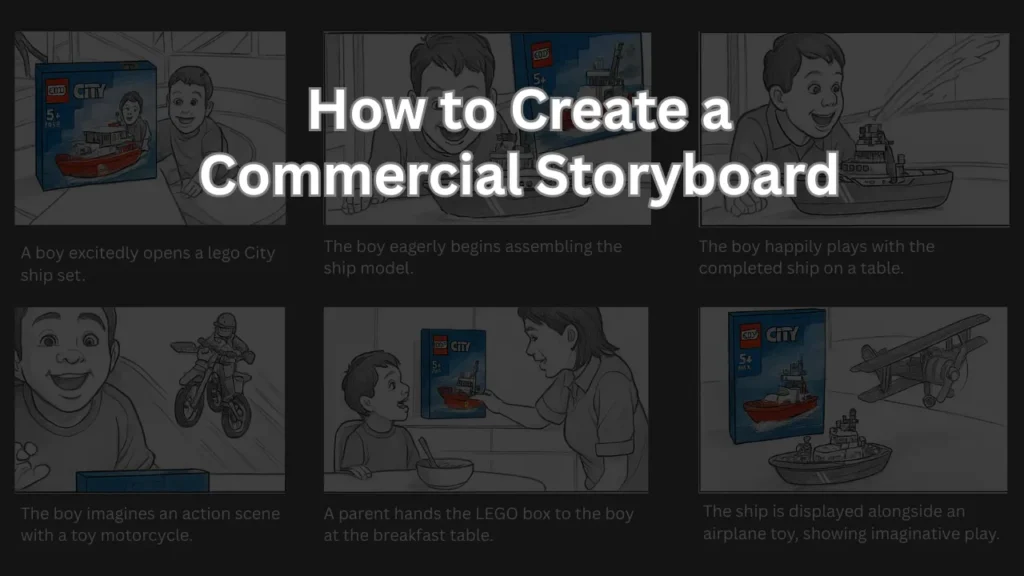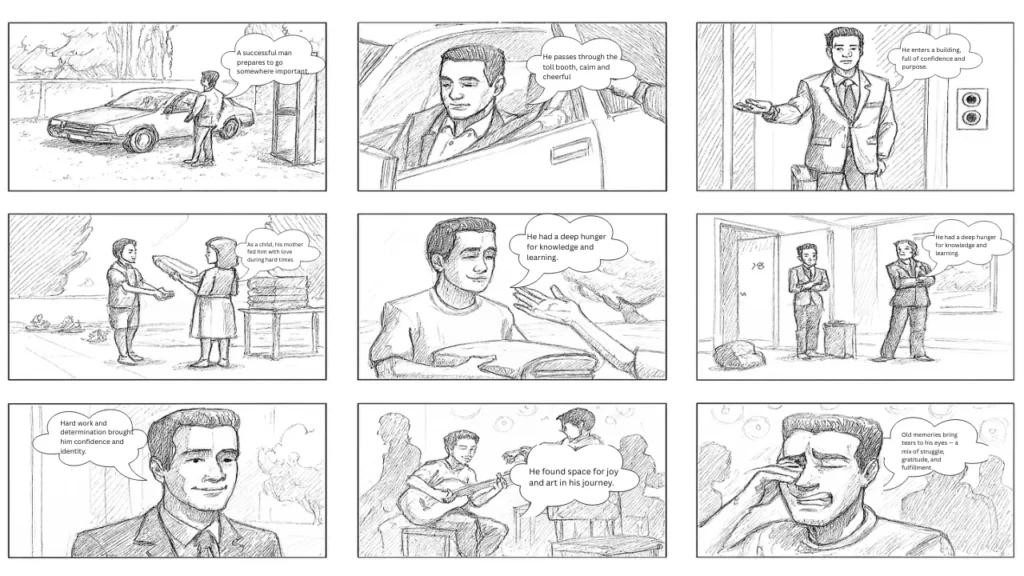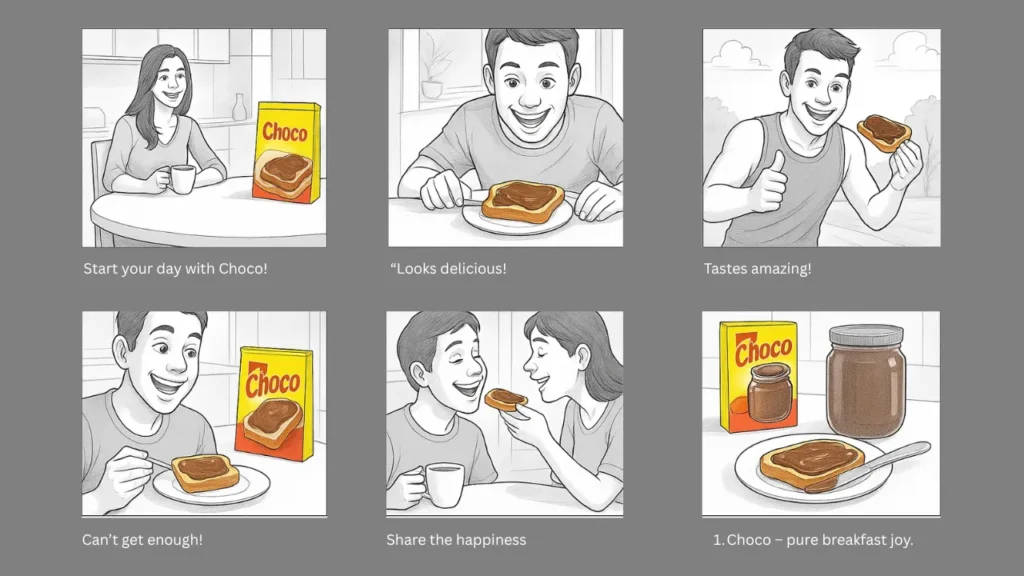How to Create a Commercial Storyboard: From Concept to Conversion

Ever watched a TV commercial that instantly grabbed your attention? That impact doesn’t happen by chance—it starts with a well-crafted commercial storyboard. Whether it’s a high-budget television commercial storyboard or a short digital ad, storyboarding helps turn your creative idea into a clear, effective message.
A storyboard maps out each scene, showing how visuals, text, and audio will work together to tell your brand story. It aligns teams, saves time, and ensures the final ad connects with your audience. From product showcases to emotional storytelling, every element starts here.
Even if you’re not a designer, tools like a storyboard template make planning easy. And with a storyboard video maker, you can create polished presentations that bring your vision to life.
In a competitive market, a compelling storyboard isn’t optional—it’s the foundation of ads that convert and campaigns that stick.
How to Create a Commercial Storyboard That Sells Your Product
If you’re thinking, “I have a great product—why isn’t it selling through ads?”, the missing link is often visual storytelling. A storyboard for commercials isn’t just a set of pretty frames—it’s a sales machine in visual form. The key is mapping your product’s unique selling point to your audience’s emotional triggers.
You start with who your audience is and what problem they’re trying to solve. Then you build scenes that resonate—not just inform. Think close-ups of product benefits, emotional cutaways, and reactions that spark desire. Every frame should push the viewer one step closer to action.
And Here’s the Insider Tip: show, don’t tell. Visual metaphors, motion graphics, and punchy voice-overs beat boring talking heads every time. As someone who has storyboarded for both startups and high-budget brands, I’ve learned one truth: storyboards that sell aren’t just made—they’re crafted.
Not a sketch artist? No problem. Use an online storyboard maker to organize your ideas, visuals, and script into a polished, pitch-ready format.

Step-by-Step Guide to Storyboarding a TV Commercial
So, you’ve got a brilliant idea for your commercial campaign—and now you’re thinking of learning everything from YouTube tutorials or paid online courses or even considering hiring an expensive agency. But stop right there. You don’t need to spend hundreds of dollars or countless hours trying to figure it all out.
With the right guidance and structure, you can storyboard your own professional-looking commercial—no film school required. Just follow the steps below, and you’ll be able to turn your creative vision into a high-impact ad. Plus, we offer free storyboarding templates to help you start faster and more efficiently.
1. Define Your Objective
Start with the goal. Is it product awareness? Lead generation? A flash sale? The purpose will guide the tone, pacing, and structure of your storyboard.
2. Write a Focused Script
Your script is the spine of your ad. Keep it tight and on-brand. For TV ads, think in 15, 30, or 60-second formats. The message should be clear from the first few seconds.
3. Break It Down into Visual Scenes
Divide the script into individual scenes. Each scene should highlight one main idea, feature, or emotion. Use this to plan out the visual flow—what your audience will see, feel, or hear at every step.
4. Add Visual Cues and Camera Notes
This is where your storyboard takes shape. You can sketch manually or use a storyboarding tool to add camera angles, transitions, dialogues, and audio cues. This helps both creatives and clients visualize the direction clearly.
5. Collaborate and Refine
Now bring in your team—designers, copywriters, marketers. Get feedback to make sure the storyboard aligns with your brand’s voice, visual identity, and marketing goals. Small tweaks now save large production mistakes later.
Commercial Storyboard Examples That Boost Brand Recall
Visual storytelling leaves a lasting impression when done right. Great TV commercial storyboard examples often use a combination of striking visuals, minimal dialogue, and clever pacing. For instance, the famous Apple “1984” ad relied on dystopian imagery and subtle symbolism to reinforce its message. Sample TV commercial storyboards often include mood boards, annotated sketches, and visual cues for movement and transitions.
Look through free story board websites for inspiration across industries like tech, food, fashion, and finance.

Top Mistakes to Avoid When Creating a Commercial Storyboard
Avoid these common pitfalls:
- Overloading visuals: Keep it clean and focused.
- Neglecting audience perspective: Your storyboard must speak to your customer’s mindset.
- Lack of flow: Transitions between scenes should be logical and emotionally engaging.
- Skipping audio cues: Music and voiceovers influence perception and must be noted.
- Ignoring brand identity: Colors, fonts, and tone must reflect your brand.
Using a storyboard video maker helps you visualize the finished product before production begins.

The Role of Storyboards in Creating Impactful Ad Campaigns
The best ads don’t happen by accident. A storyboard shapes the entire creative direction of your ad campaign. It ensures consistency in tone, visuals, and message. Before casting or filming begins, marketing and creative teams can fine-tune the visuals using a storyboard template, helping avoid costly reshoots and miscommunication.
When multiple campaigns are running across TV, digital, and print, storyboards ensure all content aligns seamlessly with brand goals.
TV Commercial Storyboard vs. Digital Ad Storyboard: What’s the Difference?
| Aspect | TV Commercial Storyboard | Digital Ad Storyboard |
|---|---|---|
| Platform | Traditional television | Social media, websites, YouTube, streaming platforms |
| Length & Timing | Fixed durations (15s, 30s, 60s) | Flexible timing; often skippable or short-form content |
| Structure | Linear narrative with clear beginning, middle, and end | May be non-linear, interactive, or looped |
| Visual Style | High production, cinematic feel | Mobile-optimized, fast-paced, attention-grabbing |
| Interactivity | None | Often includes clickable elements, CTA buttons, swipe-ups |
| Editing & Story Flow | Typically follows a script with voiceover, scenes, and effects | More dynamic with animations, transitions, and real-time edits |
| Audience Engagement | Passive viewing | Engages users through interaction and quick visual hooks |
| Usage of Tools | Requires precise planning, often shared with production teams | Easily created using a digital storyboard creator for fast deployment |
Pro Tip: Both formats can benefit from a clear visual plan. Choose the one that best suits your audience and campaign goals—or combine both for maximum reach.
The Psychology Behind Effective Storyboarding in Commercials
Great commercials don’t just sell—they connect. An effective storyboard uses psychology to guide the viewer’s emotions and decisions. By tapping into human instincts like curiosity, trust, and desire, you create a visual journey that feels personal.
Warm colors evoke comfort, quick cuts build urgency, and relatable characters spark empathy. Before viewers even realize it, they’re emotionally invested—and ready to take action. A strategic storyboard doesn’t just tell a story; it gently nudges the audience toward conversion, making them feel like they chose your brand.
Frequently Asked Questions (FAQs)
What is a commercial storyboard and why do I need one for my ad?
A commercial storyboard is a visual plan that outlines each scene of your advertisement before production. At Immersfy, we use it to ensure your ad tells a compelling story, connects emotionally, and drives conversions effectively.
How does Immersfy create TV commercial storyboards?
Our team follows a strategic, step-by-step process—from understanding your brand goals to creating detailed, frame-by-frame visuals. This helps align your message with your audience across any platform.
Can I request a storyboard for digital ads as well?
Yes! Immersfy specializes in both TV commercial storyboards and digital ad storyboards, tailored to fit platforms like YouTube, Instagram, and OTT apps for maximum engagement.
Do I need a script before contacting Immersfy?
Not necessarily. If you have an idea, our team can help you develop the script and convert it into a fully visualized storyboard.
Does Immersfy provide free storyboard templates?
Yes, we offer free storyboard templates to help creators and businesses plan their commercials with ease. They’re ideal for both beginners and professionals.
How long does it take to create a commercial storyboard with Immersfy?
On average, it takes 2–5 working days, depending on the complexity of your concept. We ensure a fast turnaround without compromising quality.
What file formats do you deliver storyboards in?
We deliver in PDF, PNG, or editable formats depending on your need—ready to share with production teams, clients, or marketing heads.
Can Immersfy help me pitch my ad idea using the storyboard?
Absolutely. We craft pitch-ready storyboards that are ideal for presenting to stakeholders, complete with annotations, camera directions, and mood cues.
Is animation storyboarding included in your services?
Yes, we provide animation storyboarding as part of our creative services—perfect for motion graphics, explainer videos, and animated commercials.
Why should I choose Immersfy for storyboarding services?
At Immersfy, we blend creative storytelling with marketing psychology. Our storyboards are not just visual—they’re designed to sell, engage, and convert, making your commercial campaign stand out in a competitive digital space.
